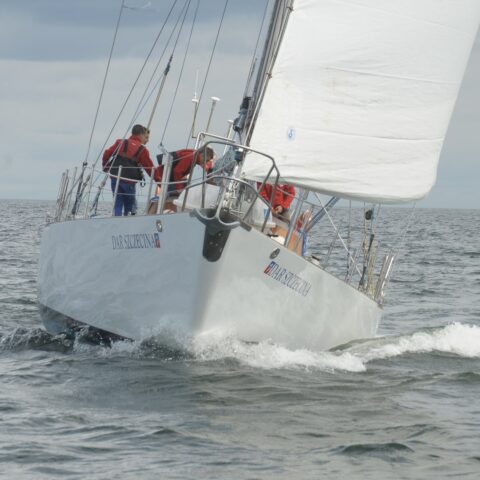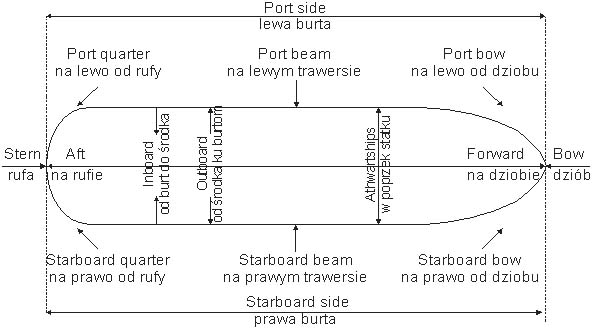Dar Szczecina is a Polish single-masted sailing yacht of the Antares type. It is a flagship of the City of Szczecin.
Built at the Szczecin-based L. Teliga Yacht Shipyard in 1968–69. Designed by Ryszard Langer and Kazimierz Michalski. The hull is made of marine-grade mahogany plywood and the deck is made of teak.
She was launched and her flag hoisted on 14th June 1969. Danuta Kopacewicz, a local sailor, became her godmother and the colours ceremony was hosted by Jerzy Szopa, the then minister of shipping. The first operator was the MKS Pogoń Sailing Team (1969-96). In 1996, the City of Szczecin became her new owner. Her regular place of stay is in the Sailing Centre in Szczecin.
Every year, the yacht cruises across the Baltic Sea, North Sea and the European part of the Atlantic. In the past two years, while on the route from St Petersburg to Cadiz, the ship has visited a number of ports. Her crew consists mainly of young people from Szczecin who are members of the Szczecin’s The Tall Ships Races Team, Marine and Sailing Education Programme, School Afloat Foundation and others. The Youth Sailing Section takes care of Dar Szczecina. Not only do young people sail and gain experience on board of the yacht, but they also help during winter renovation to keep the yacht in good shape.
Dar Szczecina participated in The Tall Ships’ Races 14 times, in 1976, 1984, 2004-2007, 2009-2013, and 2017-2019. She won the races in her class C of contemporary yachts without a spinnaker in 2006, 2010, 2012, 2013 and 2019. In 2013 and 2019, she won in the overall classification of the races.
In 2013, the yacht was awarded an honorary title of the Ambassador of Szczecin.
Lead particulars:
- Length (LOA) 18.10 m
- Beam (B) 4.60 m
- Draught (D) 3.00 m
- Crew: min. 3, max. 12
- Rig: sloop (1 mast)
- Sails: 2
- Sail area: 134 sq. m
- Motor: Beta Marine 105T
- Power: 105 HP
Navigation
Dar Szczecina has her superstructure in the midship section. It contains a spacious navigation cabin with bookshelves, table with maps and navigation aids, radio and navigation equipment, a cabinet with 12V and 230V fuses, and a comfortable revolving chair.
Radio equipment
- VHF Icom IC-M506 with AIS
- VHF Icom IC-M330
- 2 x manual VHF Icom IC-M35
- AIS Digital Yacht AIT1000 (class B) with an antenna on top of the mast
- IridiumGO, a satellite modem, with an external antenna to support satellite communication, telephone, SMS, weather forecast and e-mail
- Navtex Furuno NX-300 with an LCD to receive navigation messages
Navigation/weather equipment
- B&G Zeus2 12” chartplotter with WiFi and a set of electronic maps for the route
- Raymarine Autopilot with an LCD and hydraulic drive
- Simrad I508 with an IS20 LCD
- Simrad DST200
- Simrad NSS12 with an inbuilt GPS
- B&G RI10 Radar
- Simrad IS40 multifunction instrument display
- Mechanical inclinometer
- Mechanical barometer
- Marine clock
- Interior thermometer
- Exterior thermometer
- Navigation tools (compass, triangle, pencils, rubber, etc.)
Auxiliary navigation aids
- Nautical charts
- Printer/scanner
- Two binoculars
- Four 1kg fire extinguishers
- 12/24V converter
- Control panels for generator, main engine, navigation lights and equipment
- 230V and 12V sockets
- Navigation lamp
Engine room and technical equipment
- Beta Marine 105T 105KM engine (based on Kubota engine), speed of 6 knots at flat water and economical operation, and 8 knots max. speed.
- 230V, 160 l/h evaporator (to be fitted)
- Webasto 5.5kW heating
- potable water pressure pump
- 40l hot water boiler (engine or 230V operated)
- Automatic bilge pump
- two manual cockpit bilge pumps
- 12V engine room lights
Electrical equipment
- 12V, 24V (Webasto) and 230V installation
- 220Ah main engine start battery
- 80Ah generator start battery (to be fitted)
- 4 off grid batteries of total 860Ah (GEL)
- 215Ah anchor winch battery (GEL)
- 80Ah generator start battery,
- Fischer Panda 5000i PMS, 4kW battery (to be fitted)
- 3 x 40A chargers for batteries (230V grid)
- Silent Wind 400W generator
- 900W solar panels (to be fitted)
- residual current circuit breakers
Forepeak
Cosy but useful. Suitable for 4 people, but we never put more than 3 crew members there. Compartments under bottom beds enable to store extra clothing or equipment. Beds fitted with bedside shelves for personal belongings. Under deck food storage for juice, jars, cans, ketchup and other foodstuffs. On walls and under the ceiling attached are four life jackets, one fire extinguisher and a cabin lamp.
Living quarters “at the mast”
Five beds, including the most comfortable ones. A large freezer is fitted under one of the beds, which might be an advantage while sailing in the tropics. On walls and under the ceiling attached are five life jackets and a mobile phone charging point at the mast. Considerably large bedside shelves.
Mess cabin
A place to have a meal, meet other crew members, enjoy evening games and… a place to be envied by other crews (What a large mess cabin!). Once you are in there, you may have an impression that it occupies a half of the yacht. In fact, it extends from side to side and can seat the entire crew, or up to twenty people if we squeeze them in a bit.
Large duplex table (to be combined) to comfortably seat everyone during a fancy meal, if needed. Comfortable seats around the table with storage compartments underneath. Along sides of the mess cabin, we have six shelves for food, tools, medicine and supplies of Nutella. Water tanks are hidden under cabinets.
Galley
Although squeezed in between a mess cabin and the middle companionway, it is large enough to cook every meal. The galley contains a spacious fridge, gas stove with an oven, several cabinets and drawers with kitchen equipment, food supplies, and a sink. Safety measures include an accessible gas valve handle, fire extinguisher and a fire blanket.
Berths for permanent crew members
Situated in the navigation cabin. At the starboard, situated is the captain’s cabin with a small table, wardrobe and storage compartments. At the port side, situated is a hundberth of the captain’s deputy, who can easily access radio and navigation equipment and provide ongoing supervision of watches. Squeezed in between the two beds is yet another place to sleep which is mostly used as a storage compartment.
Bathroom
The bathroom contains a fitted washbasin, toilet bowl with a pump, shower, hot and cold water, and much space. Everything designed in wood colours.
- Marek Czasnojć
- Marek Czasnojć
- Marek Czasnojć































